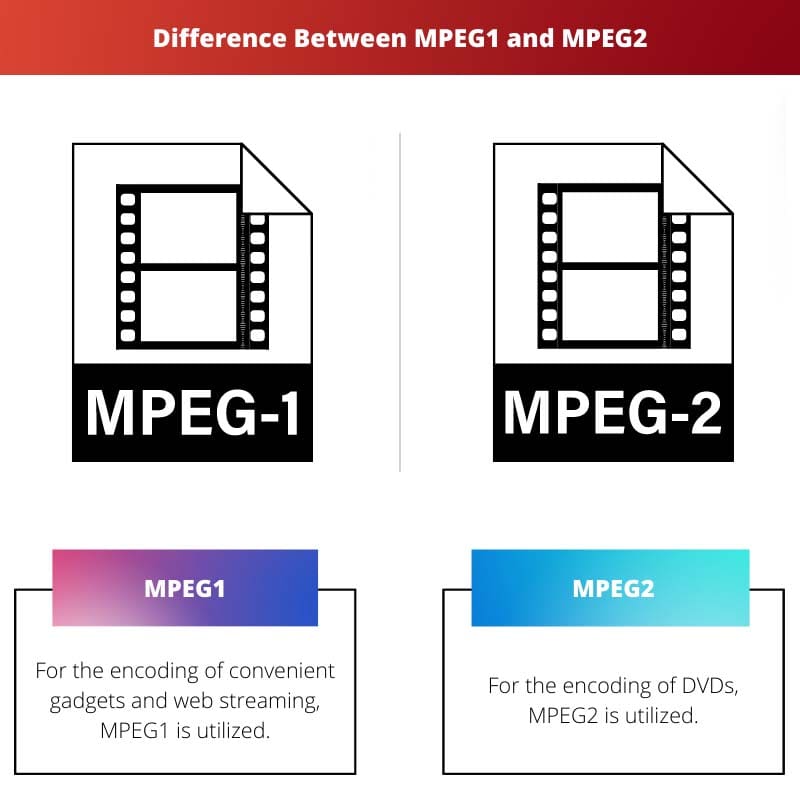MPEG represents the Moving Pictures Experts Group. This is a body that creates norms for video encoding.
The two significant principles are MPEG1 and MPEG2.
Key Takeaways
- MPEG1 is an older and less advanced compression standard than MPEG2.
- MPEG1 is suitable for lower-resolution videos, while MPEG2 is suitable for high-resolution videos.
- MPEG2 requires more storage space than MPEG1.
MPEG1 vs MPEG2
The difference between MPEG1 and MPEG2 is that MPEG1 is appropriate for convenient gadgets and web-based recordings from the web. Then again, MPEG2 is reasonable for encoding recordings and is viable with DVD media.MPEG2 was created to work with the encoding of recordings on DVDs. DVD media was an arising stage when MPEG2 was created. Afterward, web-based streaming became possibly the most important factor. MPEG2 was not viable with web-based recordings from the web, and along these lines, MPEG1 was created.

MPEG1 was helpful for convenient gadgets like cell phones and media players, in contrast to MPEG2. This additionally is a favored configuration as it gives video records of more modest sizes.
MPEG1 needs one region, which is the nature of recordings. Since it packs document size to work with a smooth exchange of video records over the web, it additionally lessens the nature of the documents.
The constraints of MPEG2 were overwhelmed by MPEG1. It could, without much of a stretch, transfer the online recordings despite the fact that both MPEG2 and MPEG4 could keep up with the video quality.
MPEG utilizes a sort of lossy pressure since certain information is eliminated. However, the diminishment of information is, for the most part, indistinct to the natural eye.
Comparison Table
| Parameters of Comparison | MPEG1 | MPEG2 |
|---|---|---|
| Encoding | For the encoding of convenient gadgets and web streaming, MPEG1 is utilized. | For the encoding of DVDs, MPEG2 is utilized. |
| Size | The size of MPEG1 recordings is more modest in contrast with MPEG2. | The size of MPEG2 recordings is greater in contrast with MPEG4. |
| Bandwidth Requirement | MPEG1 requires a more modest transfer speed in contrast with MPEG2. | MPEG2 requires a more extensive data transmission in contrast with MPEG1. |
| Quality | Video records of MPEG1 are not as great as video documents of MPEG2. | Video documents of MPEG2 are of greater. |
| Extensions | Instances of expansions of MPEG1 are: .mp1, .mp2, .mp3, .m1v, .m1a,.m2a, .mpa, .mpv and so forth. | Instances of expansions of MPEG2 are .mp2, mp3, .mpeg, and so on. |
What is MPEG1?
MPEG1 was delivered way after MPEG1 in 1999. This was the point at which the web was getting a move on.
Online recordings were arising, and web-based recordings through the web became famous. MPEG2 was not viable with convenient gadgets, and consequently, a requirement for a superior standard came up.
The impediment of MPEG2 was overwhelmed by MPEG1.
It was an arrangement that was viable with versatile gadgets like cell phones. It was likewise appropriate for media players.
This is a direct result of its refined calculation, in contrast to MPEG2. This additionally permits it to be a more adaptable organization when contrasted with MPEG2.
MPEG1 gives the extra benefit of packing the document such that the record size diminishes. This is fundamental for the exchange and real-time recordings through the web.
It uses the encoding of H.264.
MPEG1 needs one region, which is the nature of recordings. Since it packs document size to work with a smooth exchange of video records over the web, it additionally lessens the nature of the documents.
It likewise requires a lower data transmission and spot rate in contrast with MPEG2. Its cycle rate prerequisite has a scope of Kilobytes each second, in contrast to MPEG2.
Its transfer speed necessity is additionally around 64 kbps, which is extremely low when contrasted with the transmission capacity prerequisite of MPEG2 records, which is around 40 Mbps.
Consequently, MPEG4 arose as an all-inclusive organization for video documents due to its small size and low transmission prerequisites. MPEG utilizes a sort of lossy pressure since certain information is eliminated.
However, the diminishment of information is, for the most part, indistinct to the natural eye.
What is MPEG2?
The most well-known executions of the MPEG-2 standard give a video goal of 352-by-240 at 30 casings each second (fps). This produces video quality marginally beneath the nature of regular VCR recordings.
The term likewise alludes to the group of advanced video pressure norms and record designs created by the gathering. MPEG, by and large, delivers preferable quality video over contending designs, like Video for Windows, Indeo, and QuickTime.
MPEG records beforehand on PCs required equipment decoders (codecs) for MPEG preparation. Today, nonetheless, PCs can utilize programming just codecs, including items from RealNetworks, QuickTime, or Windows Media Player.
MPEG calculations pack information to shape little pieces that can be effectively sent and afterward de-pressurized. MPEG accomplishes its high-pressure rate by putting away just the progressions starting with one casing and then onto the next, rather than every whole casing.
The video data is then encoded utilizing a procedure called Discrete Cosine Transform (DCT). MPEG utilizes a sort of lossy pressure since certain information is eliminated.
However, the diminishment of information is, for the most part, indistinct to the natural eye.
Main Differences Between MPEG1 and MPEG2
- MPEG2 video documents are appropriate for DVD media and transmission. Interestingly, MPEG1 records are viable with convenient gadgets like telephones and media players.
- MPEG2 gives superior video quality when contrasted with MPEG1.
- MPEG2 has a data transmission necessity of around 40 Mbps, while MPEG1 has a transfer speed prerequisite of around 64 Kbps.
- MPEG1 is more appropriate for the transmission of recordings by means of the web when contrasted with MPEG2.
- Illustrations of MPEG2 document augmentations are mp2, mp3, .mpeg, and so forth. Illustrations of MPEG4 record augmentations are .m1a, .m1b, .m1r, .mp1, and so forth.

- https://books.google.com/books?hl=en&lr=&id=h-0gK913DsQC&oi=fnd&pg=PP2&dq=mpeg+1+and+mpeg+2&ots=uWGsK_RyOo&sig=zGvcIiNXS1O8KraLBZsGJ-gJHnI
- https://digital-library.theiet.org/content/journals/10.1049/ecej_19950606